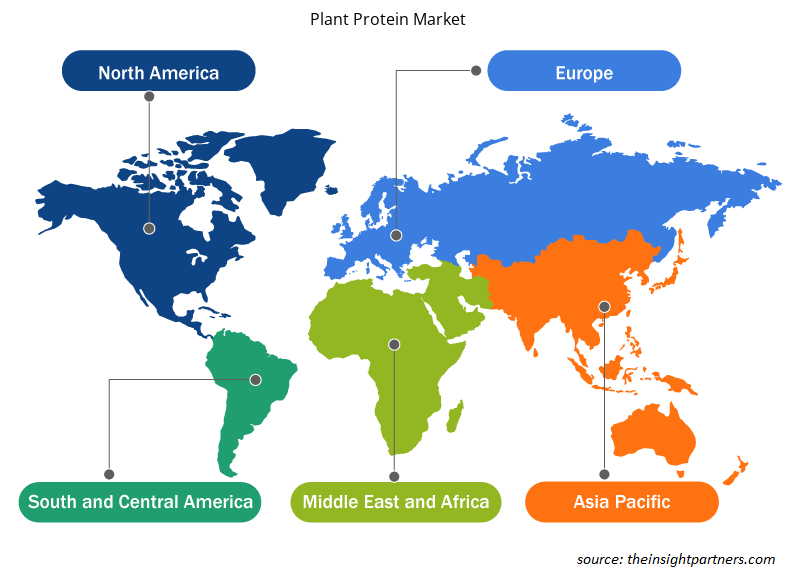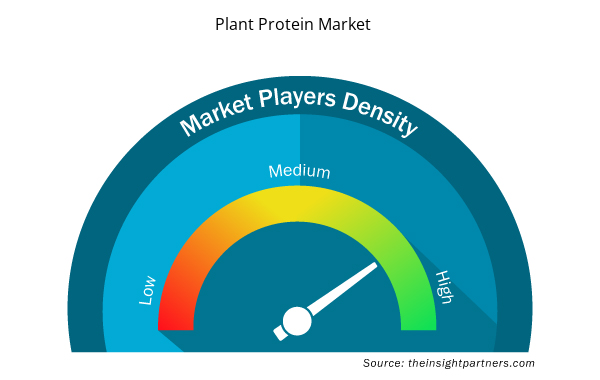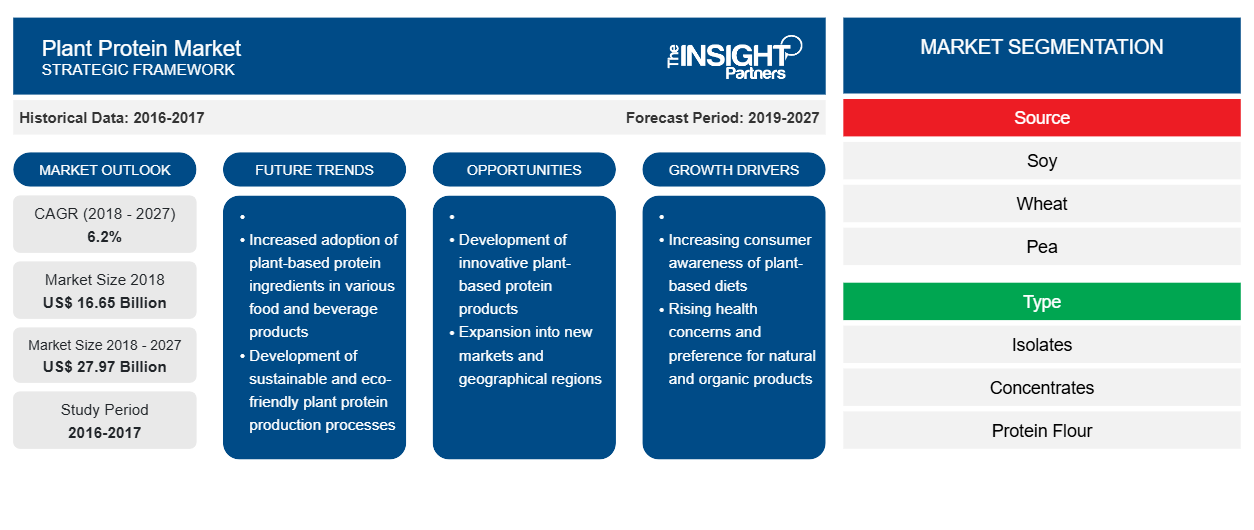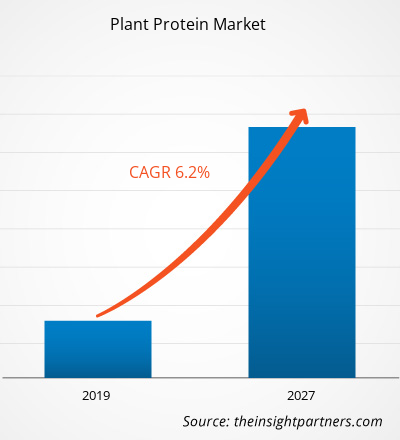Nel 2018 il mercato delle proteine vegetali era valutato 16.653,6 milioni di dollari USA e si prevede che raggiungerà i 27.965,9 milioni di dollari USA entro il 2027; si prevede una crescita a un CAGR del 6,2% dal 2019 al 2027.
Le proteine sono nutrienti vitali richiesti dal corpo umano, che sono costituiti da amminoacidi. Le proteine vegetali sono ottenute da varie fonti vegetali come soia, grano, piselli, noci e semi, tra gli altri. Varie fonti vegetali come lenticchie, ceci, arachidi, mandorle, spirulina , quinoa e semi di chia forniscono un'elevata quantità di proteine. Poiché le proteine vegetali sono povere di calorie, possono essere consumate come sostituti delle proteine animali per perdere peso. La crescente domanda di alimenti a base vegetale, unita al crescente interesse dei consumatori per gli alimenti ad alto contenuto proteico, sono i fattori chiave che stimolano la domanda di crescita del mercato delle proteine vegetali a livello globale.
Si prevede che la crescita del mercato delle proteine vegetali nell'APAC crescerà al CAGR più alto durante il periodo di previsione. La crescita del mercato delle proteine vegetali in questa regione è principalmente attribuita all'aumento del reddito disponibile con stili di vita in evoluzione come i principali fattori trainanti per le proteine vegetali nell'Asia Pacifica. La rapida crescita nel settore alimentare e delle bevande nei paesi asiatici sviluppati e in via di sviluppo come Cina, India e Giappone offre un'enorme opportunità di mercato per i produttori di proteine vegetali in quanto è ampiamente utilizzata in prodotti come bevande proteiche, alternative ai latticini, alternative alla carne e barrette proteiche
L'aumento del reddito disponibile delle persone nei paesi sviluppati e in via di sviluppo come India, Cina e Australia ha portato a un'enorme domanda di proteine vegetali in questa regione.
Personalizza questo report in base alle tue esigenze
Riceverai la personalizzazione gratuita di qualsiasi report, comprese parti di questo report, o analisi a livello nazionale, pacchetto dati Excel, oltre a usufruire di grandi offerte e sconti per start-up e università
- Scopri le principali tendenze di mercato in questo rapporto.Questo campione GRATUITO includerà analisi di dati che spaziano dalle tendenze di mercato alle stime e alle previsioni.
Approfondimenti di mercato
Crescente consapevolezza dei consumatori sugli alimenti ricchi di proteine per alimentare la crescita del mercato delle proteine vegetali
Le proteine svolgono un ruolo chiave nel trasporto di molecole in tutto il corpo, aiutando nella riparazione cellulare e proteggendo il corpo da virus e batteri. Promuove inoltre la crescita e lo sviluppo adeguati nei bambini, negli adolescenti e nelle donne incinte.
Diversi studi dimostrano che seguire una dieta ricca di proteine aiuta ad aumentare la massa e la forza muscolare e a prevenire la perdita di massa muscolare durante un programma di gestione del peso o di perdita di peso.
Le persone che consumano più proteine tendono a mantenere meglio la massa ossea e hanno un rischio molto più basso di osteoporosi e fratture. Un elevato apporto proteico ha portato a un aumento del metabolismo che si traduce nella combustione di una grande quantità di calorie. Ciò aiuta ulteriormente nella corretta gestione del peso e nella perdita di peso. Questi benefici delle proteine stanno attraendo i consumatori verso cibi e bevande ricchi di proteine disponibili sul mercato. Ciò crea ulteriormente un'enorme domanda di proteine vegetali a livello globale.
Un alimento ricco di proteine è considerato una delle tendenze più forti nel settore alimentare e delle bevande. Seguendo la tendenza delle proteine nel cibo, i produttori di alimenti e bevande stanno cercando di realizzare prodotti alimentari nutrizionali. La crescente consapevolezza dei consumatori riguardo a modi efficaci per raggiungere la perdita di peso, l'anti-invecchiamento e altri problemi di salute attraverso il consumo di alimenti ricchi di proteine sta aumentando la domanda di proteine vegetali. Inoltre, le crescenti tendenze di salute e benessere hanno creato una forte domanda di alimenti e bevande funzionali e fortificati in modo significativo negli ultimi anni. Pertanto, si prevede che la crescente consapevolezza dei consumatori riguardo agli alimenti ricchi di proteine alimenterà la crescita del mercato delle proteine vegetali
Approfondimenti basati sulla fonte
In base alla fonte, il mercato delle proteine vegetali è suddiviso in soia, grano, piselli e altri. Il segmento della soia ha rappresentato la quota di mercato maggiore nel 2018; tuttavia, si prevede che il segmento dei piselli registrerà il CAGR più elevato nel mercato durante il periodo di previsione. L'isolato di proteine di soia è una forma altamente raffinata di proteine di soia, con un contenuto proteico minimo del 90%. È prodotto da farina di soia sgrassata da cui vengono rimossi la maggior parte dei componenti non proteici, inclusi grassi e carboidrati. La polvere di proteine di soia è prodotta da fiocchi di soia sgrassati lavati in alcol o acqua per rimuovere gli zuccheri e le fibre alimentari. Vengono quindi disidratati e macinati in polvere. La polvere di proteine di soia è utilizzata per produrre formule di soia per neonati, nonché una varietà di alternative a carne e latticini. I concentrati di proteine di soia contengono in genere il 70% di proteine di soia e sono fondamentalmente farina di soia sgrassata senza carboidrati idrosolubili. Questa forma di proteina è realizzata rimuovendo parte dei carboidrati dai semi di soia decorticati e sgrassati. La farina di soia è realizzata macinando i semi di soia fino a ottenere una polvere fine.
Informazioni basate sul tipo
In base al tipo, il mercato delle proteine vegetali è segmentato in isolati, concentrati e farina proteica. Il segmento dei concentrati ha rappresentato la quota di mercato maggiore nel 2018. I concentrati di proteine vegetali sono prodotti estraendo proteine da varie fonti come soia, grano, piselli, quinoa, avena, fagioli e noci. Questi in genere forniscono il 60-80% di proteine, con il restante 20-40% composto da grassi e carboidrati. La proteina vegetale concentrata è il tipo di polvere proteica meno elaborata. Le proteine vegetali in forma concentrata aiutano i muscoli a recuperare rapidamente da un esercizio pesante poiché vengono assorbite rapidamente dal corpo. Pertanto, la facile reperibilità dei concentrati di proteine vegetali abbinata a prezzi più bassi rispetto agli isolati di proteine vegetali sono i fattori chiave che stimolano il mercato. Il concentrato di proteine vegetali tende a essere l'opzione più economica, ma offre la quantità minore di proteine rispetto agli isolati di proteine vegetali perché contiene più altri ingredienti. Questi ingredienti extra possono includere grassi, colesterolo, lattosio e glutine. I consumatori che cercano di limitare l'assunzione di grassi o hanno un sistema digerente sensibile dovrebbero evitare i concentrati di proteine vegetali.
Approfondimenti basati sulle applicazioni
In base al tipo, il mercato delle proteine vegetali è suddiviso in bevande proteiche, alternative ai latticini, alternative alla carne ed estensori di carne, barrette proteiche, prodotti da forno e altre applicazioni. Il segmento delle alternative alla carne e degli estensori di carne ha rappresentato la quota di mercato maggiore nel 2018. I prodotti alternativi alla carne includono tofu, tempeh, proteine vegetali testurizzate, seitan e Quorn, tra gli altri. Questi prodotti hanno sapore, aspetto e consistenza simili a quelli di pollame, carne e prodotti ittici. Sono realizzati utilizzando ingredienti a base di cereali e vegetali per sostituire proteine e minerali di origine animale (in particolare calcio), che aiutano a ridurre i livelli di colesterolo, prevenendo difficoltà legate alla menopausa e altri disturbi correlati. Le proteine vegetali sono ampiamente utilizzate nella produzione di alternative alla carne. I fagioli e i legumi sono fonti convenienti di proteine vegetali che fungono da sostituti della carne. Anche la soia è tra le principali fonti per la produzione di alternative alla carne. Gli isolati di proteine di piselli sono utilizzati principalmente dai produttori di alternative alla carne come Daiya, Gardein, Ben & Jerry's, Beyond Meat, Just Mayo e Ripple Foods, tra gli altri. Pertanto, l'aumento della domanda e della produzione di alternative alla carne si traduce in una maggiore domanda di proteine vegetali. La domanda di alternative alla carne è in aumento a causa delle crescenti preoccupazioni per la salute tra i consumatori e della crescente preferenza per il cibo vegano. Inoltre, i crescenti livelli di obesità dovuti al consumo di carne e prodotti a base di carne hanno portato a una crescente preferenza dei consumatori per i sostituti della carne.
Alcuni attori che operano nel mercato delle proteine vegetali sono Archer Daniels Midland Company; Axiom Foods, Inc.; Burcon NutraScience Corporation; Cargill, Incorporated; EI Du Pont De Nemours and Company; Glanbia plc; Ingredion Incorporated; Kerry Group; Koninklijke DSM NV; e Roquette Frères. Le aziende chiave implementano fusioni e acquisizioni e strategie di ricerca e sviluppo per espandere la propria base di clienti e ottenere una quota significativa nel mercato globale, il che consente loro anche di mantenere il proprio marchio a livello globale.
Approfondimenti regionali sul mercato delle proteine vegetali
Le tendenze regionali e i fattori che influenzano il mercato delle proteine vegetali durante il periodo di previsione sono stati ampiamente spiegati dagli analisti di Insight Partners. Questa sezione discute anche i segmenti e la geografia del mercato delle proteine vegetali in Nord America, Europa, Asia Pacifico, Medio Oriente e Africa e America meridionale e centrale.

- Ottieni i dati specifici regionali per il mercato delle proteine vegetali
Ambito del rapporto sul mercato delle proteine vegetali
| Attributo del report | Dettagli |
|---|---|
| Dimensioni del mercato nel 2018 | 16,65 miliardi di dollari USA |
| Dimensioni del mercato entro il 2027 | 27,97 miliardi di dollari USA |
| CAGR globale (2018 - 2027) | 6,2% |
| Dati storici | 2016-2017 |
| Periodo di previsione | 2019-2027 |
| Segmenti coperti | Per fonte
|
| Regioni e Paesi coperti | America del Nord
|
| Leader di mercato e profili aziendali chiave |
|
Densità degli attori del mercato delle proteine vegetali: comprendere il suo impatto sulle dinamiche aziendali
Il mercato delle proteine vegetali sta crescendo rapidamente, spinto dalla crescente domanda degli utenti finali dovuta a fattori quali l'evoluzione delle preferenze dei consumatori, i progressi tecnologici e una maggiore consapevolezza dei benefici del prodotto. Con l'aumento della domanda, le aziende stanno ampliando le loro offerte, innovando per soddisfare le esigenze dei consumatori e capitalizzando sulle tendenze emergenti, il che alimenta ulteriormente la crescita del mercato.
La densità degli operatori di mercato si riferisce alla distribuzione di aziende o società che operano in un particolare mercato o settore. Indica quanti concorrenti (operatori di mercato) sono presenti in un dato spazio di mercato in relazione alle sue dimensioni o al valore di mercato totale.
Le principali aziende che operano nel mercato delle proteine vegetali sono:
- Ingredion Incorporated
- Azienda Archer Daniels Midland
- Azienda Agricola Axiom Foods, Inc.
- Società di NutraScience di Burcon
- Cargill, Incorporata
Disclaimer : le aziende elencate sopra non sono classificate secondo un ordine particolare.

- Ottieni una panoramica dei principali attori del mercato delle proteine vegetali
Segnala i riflettori
- Tendenze industriali progressive nel mercato delle proteine vegetali per aiutare gli operatori a sviluppare strategie efficaci a lungo termine
- Strategie di crescita aziendale adottate dai mercati sviluppati e in via di sviluppo
- Analisi quantitativa del mercato delle proteine vegetali dal 2018 al 2027
- Stima della domanda globale di proteine vegetali
- Analisi PEST per illustrare l'efficacia degli acquirenti e dei fornitori che operano nel settore
- Sviluppi recenti per comprendere lo scenario competitivo del mercato
- Tendenze e prospettive del mercato, nonché fattori che guidano e frenano la crescita del mercato delle proteine vegetali
- Assistenza nel processo decisionale evidenziando le strategie di mercato che sostengono l'interesse commerciale, portando alla crescita del mercato
- La dimensione del mercato delle proteine vegetali in vari nodi
- Panoramica dettagliata e segmentazione del mercato, nonché dinamiche del settore delle proteine vegetali
- Dimensioni del mercato delle proteine vegetali in diverse regioni con promettenti opportunità di crescita
- Analisi storica (2 anni), anno base, previsione (7 anni) con CAGR
- Analisi PEST e SWOT
- Valore/volume delle dimensioni del mercato - Globale, regionale, nazionale
- Industria e panorama competitivo
- Set di dati Excel



Report Coverage
Revenue forecast, Company Analysis, Industry landscape, Growth factors, and Trends

Segment Covered
This text is related
to segments covered.

Regional Scope
North America, Europe, Asia Pacific, Middle East & Africa, South & Central America

Country Scope
This text is related
to country scope.
Domande frequenti
The major reason that are driving the global plant protein market are as follows: Health benefits associated with plant protein consumption: Plant-based diets are rich in nutrients like protein, magnesium, potassium, and vitamins K and C, which can improve muscle and bone health in people of all ages. Also, plant protein contains sulfur amino acids and tryptophan. These nutrients helps the body to make proteins and certain brain-signaling chemicals.
Rising consumer awareness about protein-rich food: Proteins are building blocks to maintain the structure and functions of the human body. Proteins are made up of amino acids that are attached by peptide bonds in long chains. There are 20 different kinds of amino acids linked together that determines the role of protein in the human body. Proteins play a key role in transporting molecules throughout the body by helping in cell repair and protecting the body from viruses and bacteria. It also promotes proper growth and development in children, teenagers, and pregnant women.
Global plant protein’s concentrates segment is expected to grow by a good market share. Based on type, the plant protein market is categorized into isolates, concentrates, and protein flour. These forms of plant protein are extensively used in the food and beverage industry to enhance the nutritional content of the food. The market for all the three types of plant protein is driven by various factors such as rising awareness about protein-rich diets and consumer shift towards a vegan diet globally. The high nutritional content of plant protein has exacerbated its adoption trend. The concentrates segment dominated the global plant protein market and is expected to register an exceptional growth rate during the forecast period.
The plant protein market was dominated by North America at a global level. North America comprises developed and developing countries such as the US, Canada, and Mexico. North America is likely to account for a remarkable share of the plant protein market during the forecast period. Consumers in the US and Canada are shifting their preferences toward a healthy lifestyle and prefer products that provide health benefits. While most people in North America are becoming physically active, obesity still exists as a major concern, leading to chronic cardiovascular diseases (CVD), high blood pressure, and cholesterol among masses.
Trends and growth analysis reports related to Food and Beverages : READ MORE..
The List of Companies - Plant Protein Market
- Ingredion Incorporated
- Archer Daniels Midland Company
- Axiom Foods, Inc.
- Burcon NutraScience Corporation
- Cargill, Incorporated
- E. I. Du Pont De Nemours and Company
- Glanbia plc
- Kerry Group
- Koninklijke DSM N.V.
- Roquette Frères
The Insight Partners performs research in 4 major stages: Data Collection & Secondary Research, Primary Research, Data Analysis and Data Triangulation & Final Review.
- Data Collection and Secondary Research:
As a market research and consulting firm operating from a decade, we have published and advised several client across the globe. First step for any study will start with an assessment of currently available data and insights from existing reports. Further, historical and current market information is collected from Investor Presentations, Annual Reports, SEC Filings, etc., and other information related to company’s performance and market positioning are gathered from Paid Databases (Factiva, Hoovers, and Reuters) and various other publications available in public domain.
Several associations trade associates, technical forums, institutes, societies and organization are accessed to gain technical as well as market related insights through their publications such as research papers, blogs and press releases related to the studies are referred to get cues about the market. Further, white papers, journals, magazines, and other news articles published in last 3 years are scrutinized and analyzed to understand the current market trends.
- Primary Research:
The primarily interview analysis comprise of data obtained from industry participants interview and answers to survey questions gathered by in-house primary team.
For primary research, interviews are conducted with industry experts/CEOs/Marketing Managers/VPs/Subject Matter Experts from both demand and supply side to get a 360-degree view of the market. The primary team conducts several interviews based on the complexity of the markets to understand the various market trends and dynamics which makes research more credible and precise.
A typical research interview fulfils the following functions:
- Provides first-hand information on the market size, market trends, growth trends, competitive landscape, and outlook
- Validates and strengthens in-house secondary research findings
- Develops the analysis team’s expertise and market understanding
Primary research involves email interactions and telephone interviews for each market, category, segment, and sub-segment across geographies. The participants who typically take part in such a process include, but are not limited to:
- Industry participants: VPs, business development managers, market intelligence managers and national sales managers
- Outside experts: Valuation experts, research analysts and key opinion leaders specializing in the electronics and semiconductor industry.
Below is the breakup of our primary respondents by company, designation, and region:

Once we receive the confirmation from primary research sources or primary respondents, we finalize the base year market estimation and forecast the data as per the macroeconomic and microeconomic factors assessed during data collection.
- Data Analysis:
Once data is validated through both secondary as well as primary respondents, we finalize the market estimations by hypothesis formulation and factor analysis at regional and country level.
- Macro-Economic Factor Analysis:
We analyse macroeconomic indicators such the gross domestic product (GDP), increase in the demand for goods and services across industries, technological advancement, regional economic growth, governmental policies, the influence of COVID-19, PEST analysis, and other aspects. This analysis aids in setting benchmarks for various nations/regions and approximating market splits. Additionally, the general trend of the aforementioned components aid in determining the market's development possibilities.
- Country Level Data:
Various factors that are especially aligned to the country are taken into account to determine the market size for a certain area and country, including the presence of vendors, such as headquarters and offices, the country's GDP, demand patterns, and industry growth. To comprehend the market dynamics for the nation, a number of growth variables, inhibitors, application areas, and current market trends are researched. The aforementioned elements aid in determining the country's overall market's growth potential.
- Company Profile:
The “Table of Contents” is formulated by listing and analyzing more than 25 - 30 companies operating in the market ecosystem across geographies. However, we profile only 10 companies as a standard practice in our syndicate reports. These 10 companies comprise leading, emerging, and regional players. Nonetheless, our analysis is not restricted to the 10 listed companies, we also analyze other companies present in the market to develop a holistic view and understand the prevailing trends. The “Company Profiles” section in the report covers key facts, business description, products & services, financial information, SWOT analysis, and key developments. The financial information presented is extracted from the annual reports and official documents of the publicly listed companies. Upon collecting the information for the sections of respective companies, we verify them via various primary sources and then compile the data in respective company profiles. The company level information helps us in deriving the base number as well as in forecasting the market size.
- Developing Base Number:
Aggregation of sales statistics (2020-2022) and macro-economic factor, and other secondary and primary research insights are utilized to arrive at base number and related market shares for 2022. The data gaps are identified in this step and relevant market data is analyzed, collected from paid primary interviews or databases. On finalizing the base year market size, forecasts are developed on the basis of macro-economic, industry and market growth factors and company level analysis.
- Data Triangulation and Final Review:
The market findings and base year market size calculations are validated from supply as well as demand side. Demand side validations are based on macro-economic factor analysis and benchmarks for respective regions and countries. In case of supply side validations, revenues of major companies are estimated (in case not available) based on industry benchmark, approximate number of employees, product portfolio, and primary interviews revenues are gathered. Further revenue from target product/service segment is assessed to avoid overshooting of market statistics. In case of heavy deviations between supply and demand side values, all thes steps are repeated to achieve synchronization.
We follow an iterative model, wherein we share our research findings with Subject Matter Experts (SME’s) and Key Opinion Leaders (KOLs) until consensus view of the market is not formulated – this model negates any drastic deviation in the opinions of experts. Only validated and universally acceptable research findings are quoted in our reports.
We have important check points that we use to validate our research findings – which we call – data triangulation, where we validate the information, we generate from secondary sources with primary interviews and then we re-validate with our internal data bases and Subject matter experts. This comprehensive model enables us to deliver high quality, reliable data in shortest possible time.


 Ottieni un campione gratuito per questo repot
Ottieni un campione gratuito per questo repot